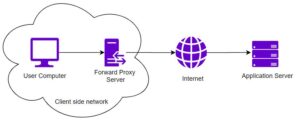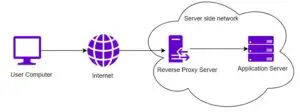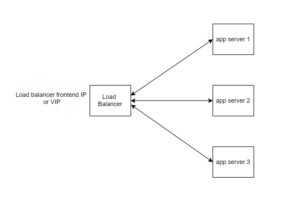Last Updated on January 27, 2024 by cscontents
Introduction
Proxy servers are server applications that work as intermediaries between clients and servers which improves privacy, security, and performance.
In the ever-evolving landscape of network architecture, the role of proxy servers has become increasingly critical in ensuring seamless and secure communication between clients and servers. Among the diverse array of proxy servers, forward proxy servers and reverse proxy servers stand out as key components that play distinct roles in managing and optimizing network traffic. Furthermore, in the broader context of network infrastructure, it’s essential to differentiate between these proxy servers and another crucial element: load balancers.
This article aims to provide a comprehensive exploration of proxy servers, focusing on forward and reverse proxies, and their unique functionalities. Additionally, we will delve into the distinctions between these proxy servers and load balancers, shedding light on their respective purposes and how they contribute to enhancing network performance, security, and scalability.
Proxy Server
Proxy is like a middle-person for your internet connection. It stands between your computer and the websites or servers you want to access. Instead of directly interacting with them, your requests and responses go through the proxy. This helps with privacy, security, and sometimes speed, depending on the type of proxy.
Taking one analogy, proxy is similar to having a friend who talks to the internet for you, making sure things work well and stay safe. Imagine you want to visit a website, but instead of going straight there, you have a proxy acting as a friendly mediator. So, you tell the proxy, “Hey, I want to see this website.” The proxy then goes and gets the website for you, and when it does, it brings it back to you.
Benefits of using Proxy
Below are the benefits of using proxy server,
Privacy Protection:
When you use a proxy server, it acts as a buffer between your computer and the websites you visit. Instead of directly revealing your IP address to the destination server, the proxy server does that on your behalf.
Access Control:
Proxies can be set up to restrict access to certain websites or content. For example, in a workplace or university, a proxy might be configured to block social media sites during working hours. It’s like having a gatekeeper who decides what’s allowed and what’s not.
Bandwidth Savings:
Proxies can cache, or store, copies of frequently accessed web pages. So, if multiple users request the same page, the proxy can serve it without fetching it again from the internet. This not only speeds up access but also saves on internet bandwidth.
Content Filtering:
Some proxies filter content based on predefined rules. They can block malicious websites or prevent access to inappropriate content.
Improved Security:
Proxies can add an extra layer of security by inspecting incoming and outgoing traffic. They can detect and block malicious activities, providing a shield against potential threats.
Anonymity for Browsing:
Certain types of proxies, like anonymous proxies, hide your IP address effectively, providing a higher level of anonymity when browsing the internet.
Network Performance Optimization:
In larger networks, proxies can optimize performance by caching content, compressing data, and prioritizing certain types of traffic.
Types of Proxy
There are many types of proxy server like
- Forward proxy
- Reverse proxy
- Transparent Proxy
- Content-Filtering Proxy
- Caching Proxy, etc.
In the article, we will focus on forward proxy and reverse proxy. Also, we will see comparison of these proxies with load balancer.
Forward Proxy Server
Forward proxy server is that server which sits at the client side in front of client machine and provide an extra layer of security by mainly hiding the actual identity of that client. Not only security, it also filters, anonymizes and optimizes these requests. Also, we can think forward proxy as representative of the client when client goes to the internet.
To understand the above statement, let’s take an example.

In the above example, if app server 1 (which is in private network, it can be any organization network) want to access any server on internet, then it has to go via the proxy server. That means the request which will be sent from app server 1, it has to go through the ‘proxy server’ and in that case the server on internet will see that request is coming from the proxy server, in other words that server will see the source IP of the request is the IP of the ‘proxy server’. In that way, we restrict the identity of the app server 1 to be exposed in the public world.
Reverse Proxy Server
Reverse proxy server sits at the server side, in front of one or more servers. It provides shielding to the application server from direct client requests.. When reverse proxy is used, request from client has to go through “reverse proxy server” and then reach to target server.
Let’s understand with an example.

In the above diagram, if the user computer which is on internet wants to access the application server which sits in the private network (e.g. any company network), in that case the user computer will send the request/traffic to the “Reverse Proxy Server” instead of sending the request to the application server directly. And then “Reverse Proxy Server” will send the traffic to the application server. In this way, we are not exposing the application server identity to the outside world.
When reverse proxy server is used in front of multiple application server, in that case it can also work as load balancer.
Load Balancer
Load balancer is such an appliance/device which is responsible for balancing the traffic load in between multiple servers. That means load balancer distributed the traffics between multiple server. The sole purpose of using a load balancer is to distribute the load between multiple servers so that any particular server does not get overloaded by traffic.

In the above diagram, for example, in the app servers we have one web application running. Here we have 3 app servers in which the same application is running. Now you can ask why we have 3 app servers where same application is running? The reason of this is, when you have only one server and if there are thousands of request comes to that server then it might crash down (because there is a limit of number of request which a web server can handle at a time), to mitigate that crashing down chance we use multiple web server and use a load balancer which can distribute the traffic load in between the multiple server.
When load balancer is used, only the load balancer IP is exposed to the outside world and no application server IP is exposed, which means by default load balancer work as a “Reverse Proxy”.
Comparison between Proxy server & Reverse Proxy server & Load Balancer
| Forward Proxy Server | Reverse Proxy Server | Load Balancer |
| Proxy server is a server which provide an extra layer of security by hiding the identity of the client. | Reverse proxy server is a such server which sits in front of any server and all the traffic to the target server has to pass through that reverse proxy server. | Load balancer is a such appliance/device which balance the load in between multiple servers. |
| Proxy server can’t work as load balancer. | Reverse Proxy server can be used in front of one server or multiple server. When it is used with multiple server it can work as load balancer. | Its sole function is to distribute the load in between multiple server. All load balancer work as a reverse proxy, but all reverse proxy not necessarily meant to work as load balancer. |
Conclusion
In wrapping up, we’ve uncovered the important roles of forward and reverse proxy servers in making sure our networks run smoothly. Forward proxies help keep our internet browsing private and safe, while reverse proxies protect our servers from potential threats.
We also took a look at load balancers, which are like traffic directors for incoming network requests. They make sure the load is spread out evenly among servers, ensuring things run efficiently and smoothly.
Understanding these differences is key for anyone working with networks. By using the right mix of forward and reverse proxies, along with load balancers, we can build strong, secure, and scalable networks. As technology keeps advancing, this knowledge becomes a handy guide for making smart decisions, adapting to changes, and creating networks that can handle the challenges of the digital age.
Thank You.
If you are interested in learning DevOps, please have a look at the below articles, which will help you greatly.
- Kubernetes Series: Part 1 – Introduction to Kubernetes | Background of Kubernetes
- Kubernetes Series: Part 2 – Components of Kubernetes cluster | Kubernetes cluster in detail
- Kubernetes Series: Part 3 – What is Minikube and How to create a Kubernetes cluster (on Linux) using Minikube?
- Introduction to Ansible | High Level Understanding of Ansible
- What is “Monitoring” in DevOps? Why do we need to Monitor App/DB servers, Transactions etc.?
- What is End-to-End Monitoring of any web application and Why do we need it?
- DevOps Engineer or Software Developer Engineer which is better for you?- Let’s discuss

